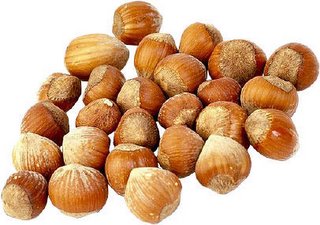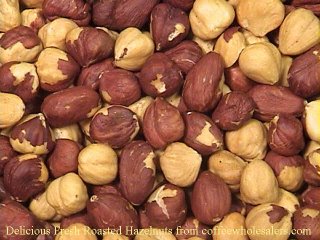 I bought hazelnut coffee last week. The smell of it reminded me of my mom’s kitchen while she was cooking brunch. She loved hazelnut coffee with cinnamon. It has a comforting and enticing aroma. The coffee has a rich flavor that tastes as good as it smells.
I bought hazelnut coffee last week. The smell of it reminded me of my mom’s kitchen while she was cooking brunch. She loved hazelnut coffee with cinnamon. It has a comforting and enticing aroma. The coffee has a rich flavor that tastes as good as it smells.As I was drinking my morning coffee, I began wondering about hazelnuts. I didn’t think that I had ever seen one or eaten one, so I decided to look them up.
After reading about them, I realized that I had eaten chocolate covered fiberts (hazelnuts), which were really yummy.
I’d like to try a few of the recipes that I found. Maybe you will, too. Enjoy!
Hazelnuts have long been a favorite in desserts and pastries. Now they are branching out into savory recipes, giving a nutty lift to meats, seafoods, and vegetables. Why are hazelnuts also called filberts? Learn about hazelnuts and filberts, how to store them, and get some cooking tips before delving into the hazelnut recipes.

Hazelnut and filbert history
Hazelnuts, a member of the Corylus botanical family, have been cultivated in China for more than 5,000 years. The hazel part of its name comes from the Anglo-Saxon word haesel meaning a headdress or bonnet, referring to the shape of outer shell covering. Hazelnuts are reputed to be native to Asia Minor, from whence they spread to Italy, Spain, France, and Germany via Greece.
Prior to the 1940s, hazelnuts were imported to the States. Today they are grown commercially in the Northwest US. Hazelnuts are about the size of a small marble. The nutmeat is encased in a hard shell that resembles an acorn without its cap. The rich, sweet nutmeat has a bitter brown paper-thin skin that is usually removed before eating. These nuts contain a wealth of oil, 88 percent unsaturated, which is pressed for use as the aromatic and delicately flavored hazelnut oil. Although it cannot be heated to high temperatures, this oil is favored by gourmets worldwide and is relatively expensive. Luckily, a little goes a long way.
Why are hazelnuts called filberts?
The most commonly accepted explanation is because hazelnuts mature on or around St. Philibert's Day, August 20. Other historians believe the term filbert derives from the German vollbart meaning full beard, a reference to the appearance of the husked shell. Although the current definition of filbert tends to refer to commercial cultivated crops of hazelnuts, the terms hazelnut and filbert are generally used interchangeably. Hazelnuts are also known as cobnuts in some areas. Other experts claim these are all different varieties of the nut, but once shelled, they are quite difficult to tell apart.
*Information from http://homecooking.about.com/cs/nuts/a/hazelnut.htm







No comments:
Post a Comment